Beko RFNE320L23X, RFNE320L23W, RFNE320L24W, RFNE320L24X User manual [EN,AR,FA,FR]

Freezer |
|||
User manual |
|||
|
|
|
رزيرفلا |
|
|
|
مدختسملا ليلد |
|
|
|
رزیرف |
|
|
|
ربراک یامنهار هچرتفد |
|
|
|
Congélateur/Réfrigérateur |
|
|
|
Manuel d'utilisation |
|
|
|
RFNE320L23X |
|
|
|
RFNE320L23W |
|
|
|
RFNE320L24W |
|
|
|
RFNE320L24X |
EN |
AR |
FA |
FR |
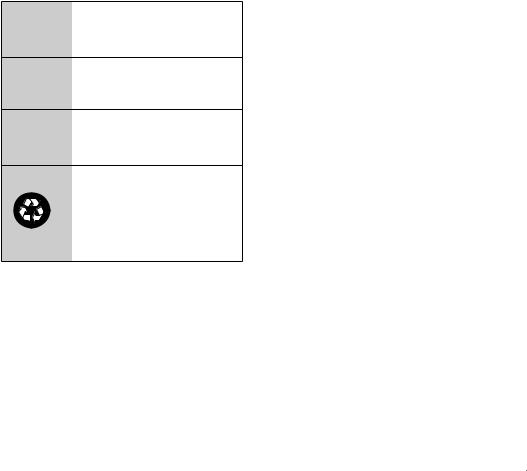
Please read this manual before using the product!
Dear Customer,
We'd like you to make the best use of our product, which has been manufactured in modern facilities with care and meticulous quality controls.
Thus, we advice you to read the entire user manual before you use the product. In case the product changes hands, do not forget to hand the guide to its new owner along with the product.
This guide will help you use the product quickly and safely.
•Please read the user guide carefully before installing and operating the product.
•Always observe the applicable safety instructions.
•Keep the user guide within easy reach for future use.
•Please read any other documents provided with the product.
Keep in mind that this user guide may apply to several product models. The guide clearly indicates any variations of different models.
C Important information and useful tips.
A Risk of life and property.
B Risk of electric shock.
The product’s packaging is made of recyclable materials, in accordance with the National Environment Legislation.

CONTENTS |
|
1 Safety and environment |
|
instructions |
4 |
General safety......................................................... |
4 |
1.1.1 HC warning..................................................... |
6 |
1.1.2 For models with water dispenser......... |
6 |
Intended use............................................................ |
6 |
Child safety............................................................... |
6 |
Compliance with WEEE Directive and |
|
Disposing of the Waste Product...................... |
6 |
Compliance with RoHS Directive...................... |
7 |
Package information.............................................. |
7 |
2 Your Freezer |
8 |
3 Installation |
9 |
Appropriate Installation Location................... |
9 |
Adjusting the Feet............................................... |
10 |
Electrical Connection.......................................... |
10 |
Reversing the doors............................................. |
11 |
4 Preparation |
12 |
5 Using your cooler/freezer 13
Setting the operating temperature. |
............ 13 |
Indicator lights...................................................... |
14 |
Thermostat knob ................................................ |
14 |
Freezing................................................................... |
14 |
Fast freeze.............................................................. |
15 |
6 Maintenance and cleaning 18 |
|
7 Troubleshooting |
19 |
Refrigerator/User Manual |
3 / 23 EN |
|
|
|
|

|
1 |
Safety and environment instructions |
|
|||||
This section provides the safety |
1.1.General safety |
|||||||
instructions necessary to prevent |
• |
This product should not |
||||||
the risk of injury and material |
|
|
be used by persons with |
|||||
damage. Failure to observe these |
|
physical, sensory and mental |
||||||
instructions will invalidate all |
|
|
disabilities, without sufficient |
|||||
types of product warranty. |
|
|
knowledge and experience |
|||||
Intended use |
|
|
or by children. The device |
|||||
|
|
|
|
|
|
can only be used by such |
||
|
|
WARNING: |
|
|
||||
|
|
|
|
persons under supervision |
||||
|
|
Keep ventilation openings, |
|
|||||
|
|
|
and instruction of a person |
|||||
|
Ain the appliance enclosure |
|
||||||
|
|
responsible for their safety. |
||||||
|
|
or in the built-instructure, |
|
Children should not be allowed |
||||
|
|
clear of obstruction. |
|
|
||||
|
|
|
|
to play with this device. |
||||
|
|
WARNING: |
|
|
||||
|
|
|
• In case of malfunction, unplug |
|||||
|
|
Do not use mechanical |
|
the device. |
||||
|
|
devices or other means to |
• After unplugging, wait at least |
|||||
|
|
accelerate the defrosting |
|
5 minutes before plugging in |
||||
|
Aprocess, other than those |
|
again. |
|||||
|
|
recommended by the |
|
• Unplug the product when not |
||||
|
|
manufacturer. |
|
|
in use. |
|||
|
|
WARNING: |
|
• Do not touch the plug with |
||||
|
ADo not damage the |
|
|
wet hands! Do not pull the |
||||
|
|
refrigerant circuit. |
|
|
cable to plug off, always hold |
|||
|
|
WARNING: |
|
|
the plug. |
|||
|
|
Do not use electrical |
|
• Do not plug in the refrigerator |
||||
|
|
appliances inside the food |
|
if the socket is loose. |
||||
|
|
storage compartments |
• Unplug the product during |
|||||
|
Aof the appliance, unless |
|
installation, maintenance, |
|||||
|
|
they are of the type |
|
|
cleaning and repair. |
|||
|
|
recommended by the |
|
• If the product will not be used |
||||
|
|
manufacturer. |
|
|
for a while, unplug the product |
|||
|
|
|
|
|
|
and remove any food inside. |
||
This appliance is intended to be |
|
|||||||
• Do not use the product when |
||||||||
used in household and similar |
|
the compartment with circuit |
||||||
applications such as |
|
|
cards located on the upper |
|||||
– staff kitchen areas in shops, |
|
back part of the product |
||||||
offices and other working |
|
|
(electrical card box cover) (1) |
|||||
environments; |
|
|
is open. |
|||||
– farm houses and by clients |
|
|
|
|
|
|||
in hotels, motels and other |
|
|
|
|
|
|||
residential type environments; |
|
|
|
|
||||
– bed and breakfast type |
|
|
|
|
|
|||
environments; |
|
|
|
|
|
|||
– catering and similar non-retail |
|
|
|
|
||||
applications. |
|
4 / 23 EN |
|
Refrigerator/User Manual |
||||
|
|
|
|
|
|
|
|
|
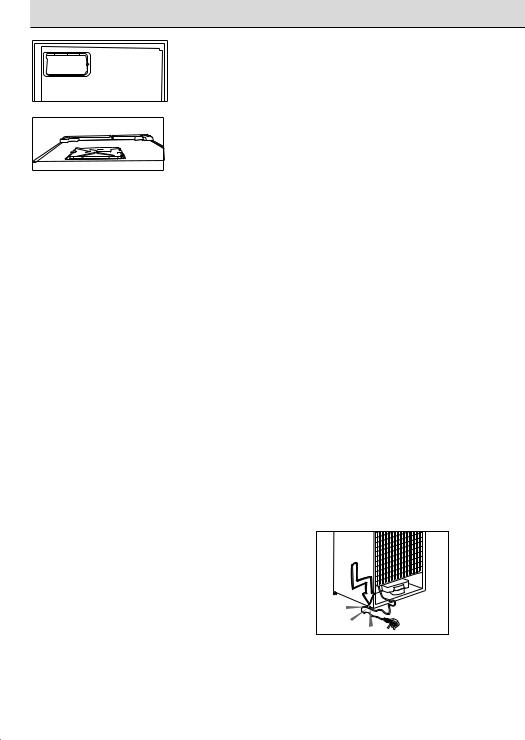
Safety and environment instructions
1
1 |
•Do not use steam or steamed cleaning materials for cleaning the refrigerator and melting the ice inside. Steam may contact the electrified areas and cause short circuit or electric shock!
•Do not wash the product by spraying or pouring water on it! Danger of electric shock!
•In case of malfunction, do not use the product, as it may cause electric shock. Contact the authorised service before doing anything.
•Plug the product into an earthed socket. Earthing must be done by a qualified electrician.
•If the product has LED type lighting, contact the authorised service for replacing or in case of any problem.
•Do not touch frozen food with wet hands! It may adhere to your hands!
•Do not place liquids in bottles and cans into the freezer compartment. They may explode.
•Place liquids in upright position after tightly closing the lid.
•Do not spray flammable substances near the product, as it may burn or explode.
•Do not keep flammable materials and products with flammable gas (sprays, etc.) in the refrigerator.
•Do not place containers holding liquids on top of the product. Splashing water on an electrified part may cause electric shock and risk of fire.
•Exposing the product to rain, snow, sunlight and wind will cause electrical danger. When relocating the product, do not pull by holding the door handle. The handle may come off.
•Take care to avoid trapping any part of your hands or body in any of the moving parts inside the product.
•Do not step or lean on the door, drawers and similar parts of the refrigerator. This will cause the product to fall down and cause damage to the parts.
•Take care not to trap the power cable.
Refrigerator/User Manual |
5 / 23 EN |
|
|
|
|
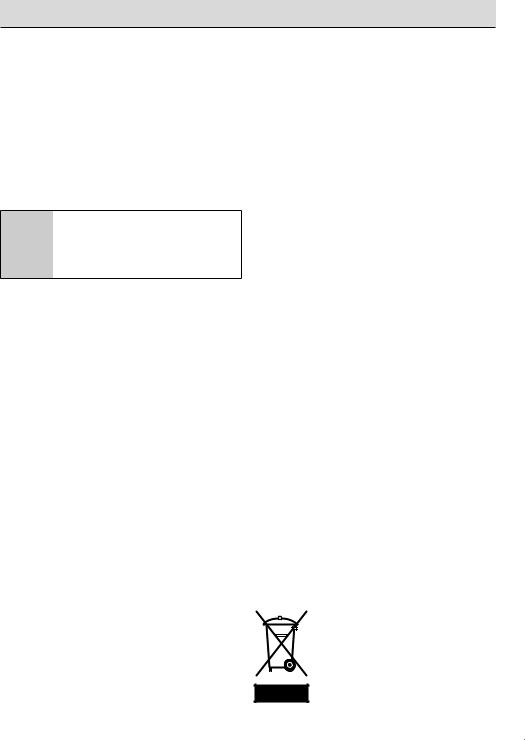
Safety and environment instructions
1.1.1 HC warning
If the product comprises a cooling system using R600a gas, take care to avoid damaging the cooling system and its pipe while using and moving the product. This gas is flammable. If the cooling system is damaged, keep the product away from sources of fire and ventilate the room immediately.
The label on the inner C left side indicates the type of gas used in the
product.
1.1.2 For models with water dispenser
• Pressure for cold water inlet shall be maximum 90 psi (6.2 bar). If your water pressure exceeds 80 psi (5.5 bar), use a pressure limiting valve in your mains system. If you do not know how to check your water pressure, ask for the help of a professional plumber.
• If there is risk of water hammer effect in your installation, always use a water hammer prevention equipment in your installation. Consult Professional plumbers if you are not sure that there is no water hammer effect in your installation.
• Do not install on the hot water inlet. Take precautions against of the risk of freezing of the hoses. Water temperature operating interval shall be 33°F (0.6°C) minimum and 100°F (38°C) maximum.
• Use drinking water only.
1.2.Intended use
• This product is designed for home use. It is not intended for commercial use.
• The product should be used to store food and beverages only.
• Do not keep sensitive products requiring controlled temperatures (vaccines, heat sensitive medication, medical supplies, etc.) in the refrigerator.
• The manufacturer assumes no responsibility for any damage due to misuse or mishandling.
• Original spare parts will be provided for 10 years, following the product purchasing date.
1.3.Child safety
• Keep packaging materials out of children’s reach.
• Do not allow the children to play with the product.
• If the product’s door comprises a lock, keep the key out of children’s reach.
1.4. Compliance with WEEE Directive and Disposing
of the Waste Product
This product complies with EU WEEE Directive (2012/19/EU). This product bears a classification symbol for waste electrical and electronic equipment (WEEE).
This product has been manufactured with high quality parts and materials which can be reused and are suitable for recycling. Do not dispose of the waste
product with normal domestic
|
6 / 23 EN |
Refrigerator/User Manual |
|
|
|

Safety and environment instructions
and other wastes at the end of its service life. Take it to the collection center for the recycling of electrical and electronic equipment. Please consult your local authorities to learn about these collection centers.
1.5.Compliance with RoHS Directive
• This product complies with EU WEEE Directive (2011/65/EU). It does not contain harmful and prohibited materials specified in the Directive.
1.6.Package information
• Packaging materials of the product are manufactured from recyclable materials in accordance with our National Environment Regulations. Do not dispose of the packaging materials together with the domestic or other wastes. Take them to the packaging material collection points designated by the local authorities.
Refrigerator/User Manual |
7 / 23 EN |
|
|
|
|

2 Your Freezer
1 


2
3
4
1.Control Panel
2.Flap
3.Drawers
4.Adjustable front feet
Figures that take place in this instruction manual are schematic and C may not correspond exactly with your product. If the subject parts are
not included in the product you have purchased, then it is valid for other models.
|
8 / 23 EN |
Refrigerator/User Manual |
|
|
|
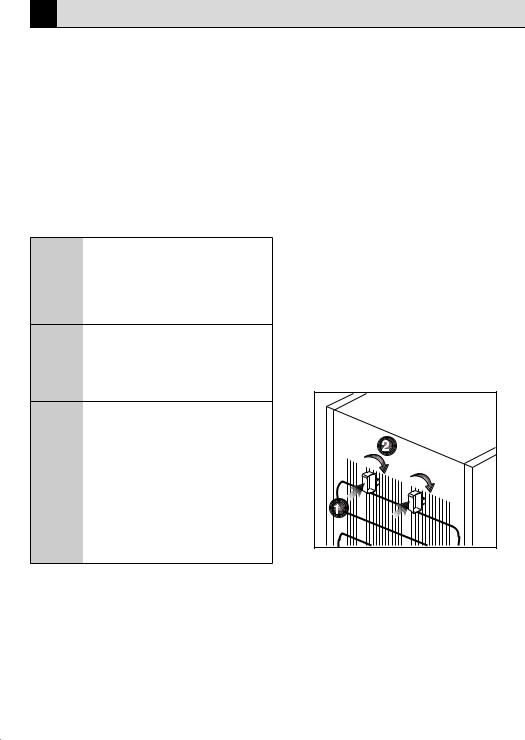
3Installation
3.1.Appropriate Installation Location
Contact an Authorized Service for the installation of the product. In order to prepare the product for use, refer the information in the user manual and ensure that electrical installation and water installation are appropriate. If not, call a qualified electrician and technician to have any necessary arrangements carried out.
WARNING: Manufacturer shall Bnot be held liable for damages
that may arise from procedures carried out by unauthorized persons.
WARNING: Product must Bnot be plugged in during
installation. Otherwise, there is the risk of death or serious injury!
WARNING:
If the door clearance of the room where the product shall be place is so tight to prevent
Apassing of the product, remove the door of the room and pass the product through the door by turning it to its side; if this does not work, contact the
authorized service.
• Placetheproductonanevenfloor surface to prevent jolts.
• Installtheproductatleast30cm away from heat sources such as hobs, heater cores and stoves and at least 5 cm away from electrical ovens.
• Productmustnotbesubjectedto direct sun light and kept in humid places.
• Appropriateairventilationmustbe
provided around your product in order to achieve an efficient operation. If the product is to be placed in a recess in the wall, pay attention to leave at least 5 cm distance with the ceiling and side walls.
Installing the Plastic Wedges
Plastic wedges supplied with the product are used to create the distance for the air circulation between the product and the rear wall.
1.To install the wedges, remove the screws on the product and use the screws supplied together with the wedges.
2.Insert the 2 plastic wedges onto the rear ventilation cover as illustrated in the figure.
Refrigerator/User Manual |
9 / 23 EN |
|
|
|
|
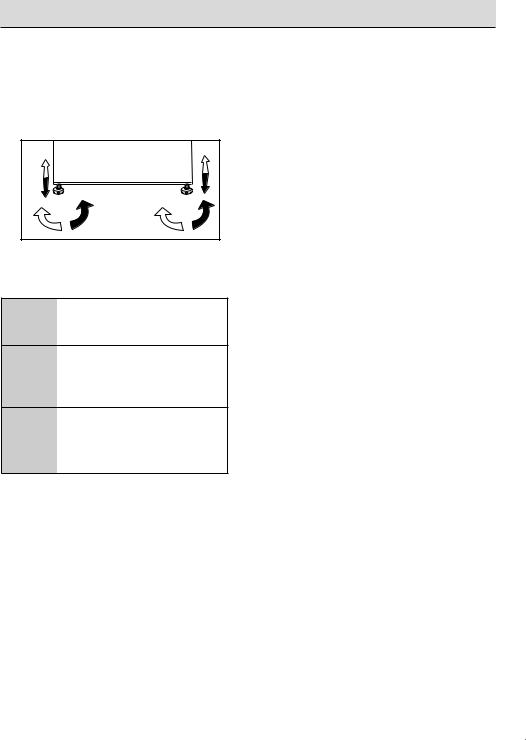
Installation
3.2. Adjusting the Feet
If the product stands unbalanced after installation, adjust the feet on the front by rotating them to the right or left.
3.3. Electrical Connection
A WARNING: Do not make connections via extension cables or multi-plugs.
WARNING: Damaged
B power cable must be replaced by the Authorized Service Agent.
If two coolers are to be C installed side by side, there
should be at least 4 cm distance between them.
•Our company shall not be liable for any damages that will arise when the product is used without
grounding and electrical connection in accordance with the national regulations.
•Power cable plug must be within easy reach after installation.
•Connect your refrigerator to a grounded outlet rated for a voltage value of 220-240V /50 Hz. Outlet shall have 10 to 16A fuse.
•Do not extension cords or cordless multiple outlets between your product and the wall outlet.
|
10 / 23 EN |
Refrigerator/User Manual |
|
|
|
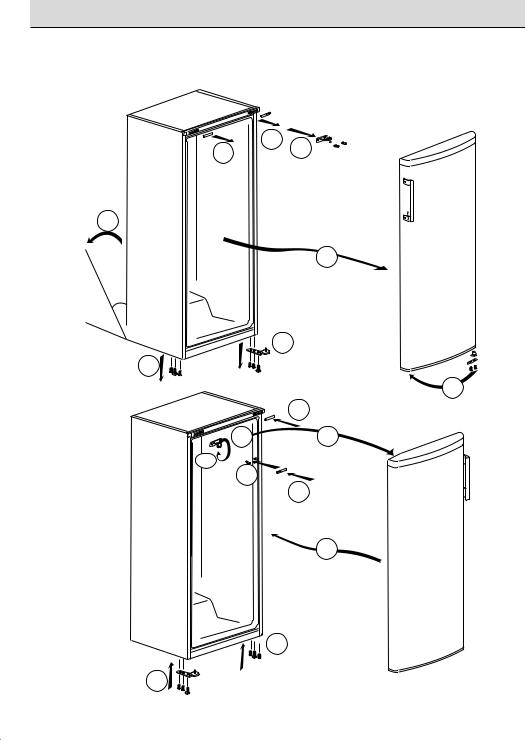
Installation
Reversing the doors
Proceed in numerical order .
1 2 3
5
4
45°
|
7 |
6 |
|
|
8 |
|
15 |
11 |
12 |
180°
14
15
13
10 |
9 |
Refrigerator/User Manual |
11 / 23 EN |
|
|
|
|

4 Preparation
•Your cooler/freezer should be installed at least 30 cm away from heat sources such as hobs, ovens, central heater and stoves and at least 5 cm away from electrical ovens and should not be located under direct sunlight.
•Please make sure that the interior of your cooler/freezer is cleaned thoroughly.
•If two coolers are to be installed side by side, there should be at least 2 cm distance between them.
•When you operate your cooler/freezer for the first time, please observe the following instructions during the initial six hours.
•Its door should not be opened frequently.
•It must be operated empty without placing any food in it.
•Do not unplug your cooler/freezer. If a power failure occurs out of your control, please see the warnings in the “Recommended solutions for the problems” section.
•The baskets/drawers that are provided with the chill compartment must always be in use for low energy consumption and for better storage conditions.
•Food contact with the temperature sensor in the freezer compartment may increase energy consumption of the appliance. Thus any contact with the sensor(s) must be avoided.
•This product has been designed to function at ambient temperatures up to 43 °C (90 SDgrF). Even if the ambient temperature falls to -15 °C, frozen food in the freezer does not thaw thanks to its Advanced Electronic Temperature
Control System. For the first installation, the product should NOT be placed under low ambient temperatures. This is because the freezer cannot go down to standard operation temperature. When reaching continuous operation, the product can be moved to another place. Thus, later you can place your product in the garage or an unheated room without the concern of causing frozen food to get rotten. However,
it is likely that above mentioned low temperatures may cause the freezing of the food in the fridge compartment; thus, please consume the food items in the fridge in a controlled way as needed. When ambient temperature goes back to normal, you may change button setting according to your need.
•If the ambient temperature is below 0°C, the food in fridge compartment will freeze. Therefore, we recommend not using the fridge compartment
in such low ambient temperatures. You may continue to use the freezer compartment as usual.
•In some models, the instrument panel automatically turns off 5 minutes after the door has closed. It will be reactivated when the door has opened or pressed on any key.
•Due to temperature change as a result of opening/closing the product door during operation, condensation on the door/body shelves and the glass containers is normal.
|
12 / 23 EN |
Refrigerator/User Manual |
|
|
|
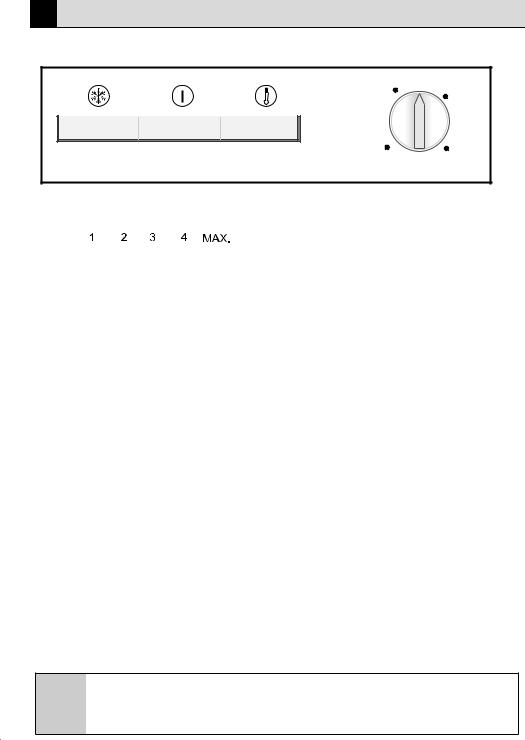
5 Using your cooler/freezer
5.1.Setting the operating temperature
3 |
4 |
|
2 
1 |
MAX. |
Warm




 Cold
Cold
The operating temperature is regulated by the temperature control.
1 = Lowest cooling setting (Warmest setting)
MAX. = Highest cooling setting (Coldest setting)
Please choose the setting according to the desired temperature.
The interior temperature also depends on ambient temperature, the frequency with which the door is opened and the amount of foods kept inside.
Frequently opening the door causes the interior temperature to rise.
For this reason, it is recommended to close the door again as soon as possible after use.
The normal storage temperature of your appliance should be -18 °C (0 °F). Lower temperatures can be obtained by adjusting the thermostat knob towards Position MAX.
We recommend checking the temperature with a thermometer to ensure that the storage compartments are kept to the desired temperature. Remember to take the reading immediately since the thermometer temperature will rise very rapidly after you remove it from the freezer.
Figures in this user manual are schematic and may not match the product C exactly. If the subject parts are not included in the product you have
purchased, then those parts are valid for other models.
Refrigerator/User Manual |
13 / 23 EN |
|
|
|
|

Operating the product
5.2.Indicator lights
There are three coloured indicator lights located inside the appliance which show the operating mode of the freezer.
Amber Indicator
Illuminates when the thermostat knob is turned to MAX. position and stays on until the fast freeze operation is deactivated manually.
Fast-freeze operation is for freezing fresh food.
Green Indicator
Illuminates when the appliance is connected to the mains and will glow as long as there is electricity present. The green indicator does not give any indication of the temperature inside the freezer.
Red Indicator High Temperature Alarm
After the appliance is turned on for the first time the alarm is not active for 12 hours (The red LED indicator is switched off).
After this period of time the red LED indicator is switched on in the following
situations:
-If the appliance is overloaded with fresh food -If the door is left open by
mistake.In these situations the red LED indicator will continue to be switched on until the appliance reaches the preset temperature. If the red LED indicator is still switched on then wait for 24 hours before calling service.
5.3.Thermostat knob
The thermostat knob is located on the indicator light frame.
Important:
When you press the fast-freeze switch or adjust the set temperature, there may be a short delay before the compressor starts to operate. This is normal and not a compressor fault.
5.4.Freezing
Freezing food
You can use the appliance for freezing fresh food as well as for storing prefrozen food.
Please refer to the recommendations given on the packaging of your food.
• Attention
Do not freeze fizzy drinks, as the bottle may burst when the liquid in it is frozen.
Be careful with frozen products such as coloured ice-cubes.
Do not exceed the freezing capacity of your appliance in 24 hours. See the rating label.
In order to maintain the quality of the food, the freezing must be effected as rapidly as possible.
Thus, the freezing capacity will not be exceeded, and the temperature inside the freezer will not rise.
• Attention
Keep the already deep-frozen food always separated with freshly placed food.
|
14 / 23 EN |
Refrigerator/User Manual |
|
|
|

Operating the product
When deep-freezing hot food, the cooling compressor will work until the food is completely frozen. This can temporarily cause excessive cooling of the refrigeration compartment.
If you find the freezer door difficult to open just after you have closed it, don’t worry. This is due to the pressure difference which will equalize and allow the door to open normally after a few minutes.
You will hear a vacuum sound just after closing the door. This is quite normal.
5.5.Fast freeze
If large amounts of fresh food are going to be frozen, adjust the control knob to max. 24 hours before putting the fresh food in the fast freeze compartment.
It is strongly recommended to keep the knob at MAX. position at least 24 hours to freeze maximum amount of fresh food declared as freezing capacity. Take special care not to mix frozen food and fresh food.
Remember to turn the thermostat knob back to its previous position once food has frozen.
Defrosting
The freezer compartment defrosts automatically.
Refrigerator/User Manual |
15 / 23 EN |
|
|
|
|

Operating the product
Freezing fresh food
•It must be preferred to wrap or cover the food before placing them in the refrigerator.
•Hot food must cool down to the room temperature before putting them in the refrigerator.
•The foodstuff that you want to freeze must be fresh and in good quality.
•Foodstuff must be divided into portions according to the family’s daily or meal based consumption needs.
•The foodstuff must be packaged in an airtight manner to prevent them from drying even if they are going to be kept for a short time.
•Materials to be used for packaging must be tear-proof and resistant to cold, humidity, odor, oils and acids and they must also be airtight. Moreover, they must be well closed and they must be made from easy-to-use materials that are suitable for deep freeze usage.
•Frozen food must be used immediately after they are thawed and they should never be re-frozen.
•Please observe the following instructions to obtain the best results.
1.Do not freeze too large quantities of food at one time. The quality of the food is best preserved when it is frozen right through to the core as quickly as possible.
2.Placing warm food into the freezer compartment causes the cooling system to operate continuously until the food is frozen solid.
3.Take special care not to mix already frozen food and fresh food.
Recommendations for preservation of frozen food
•Prepacked commercially frozen food should be stored in accordance with the frozen food manufacturer's instructions for a  ( 4 star) frozen food storage compartment.
( 4 star) frozen food storage compartment.
•To ensure that the high quality achieved by the frozen food manufacturer and the food retailer is maintained, the following should be remembered:
1.Put packages in the freezer as quickly as possible after purchase.
2.Ensure that contents are labeled and dated.
3.Do not exceed "Use By", "Best Before" dates on the packaging.
Defrosting |
|
|
|
The freezer |
compartment defrosts |
||
automatically. |
|
|
|
Placing the food |
|
||
|
Freezer compartment |
Various frozen food such |
|
|
as meat, fish, ice cream, |
||
|
shelves |
|
|
|
|
vegetables and etc. |
|
|
|
|
|
|
|
|
|
|
Egg tray |
|
Egg |
|
|
|
|
|
Fridge compartment |
Food in pans, covered |
|
|
plates and closed |
||
|
shelves |
|
|
|
|
containers |
|
|
|
|
|
|
|
|
|
|
Fridge compartment |
Small and packaged food |
|
|
or drinks (such as milk, fruit |
||
|
door shelves |
|
|
|
|
juice and beer) |
|
|
|
|
|
|
|
|
|
|
Crisper |
|
Vegetables and fruits |
|
|
|
|
|
16 / 23 EN |
Refrigerator/User Manual |
|
|
|

Operating the product
Freshzone |
Delicatessen products |
|
(cheese, butter, salami |
||
compartment |
||
and etc.) |
||
|
Deep-freeze information
Food must be frozen as rapidly as possible when they are put in a refrigerator in order to keep them in good quality.
It is possible to keep the food for a long time only at -18°C or lower temperatures.
You can keep the freshness of food for many months (at -18°C or lower temperatures in the deep freeze).
WARNING! A
•Foodstuff must be divided into portions according to the family’s daily or meal based consumption needs.
•Foodstuff must be packaged in an airtight manner to prevent them from drying even if they are going to be kept for a short time.
•Materials necessary for packaging:
•Cold resistant adhesive tape
•Self adhesive label
•Rubber rings
•Pen
Materials to be used for packaging the foodstuff must be tear-proof and resistant to cold, humidity, odor, oils and acids.
Foodstuff to be frozen should not be allowed to come in contact with the previously frozen items to prevent their partial thawing.
Frozen food must be used immediately after they are thawed and they should never be re-frozen.
-Active”quıck freeze function” at least 24 hour before loading fresh food.
-Put 2 pcs ice packs ( if available ) inside the bottom drawer.
-Place fresh food on the shelves of 2 nd&3rd from the bottom.(maximum capacıty can be achieved by removing the drawers
Refrigerator/User Manual |
17 / 23 EN |
|
|
|
|

6 Maintenance and cleaning
Cleaning your fridge at regular intervals will extend the service life of the product.
BWARNING:
Unplug the product before cleaning it.
•Never use gasoline, benzene or similar substances for cleaning purposes.
•Never use any sharp and abrasive tools, soap, household cleaners, detergent and wax polish for cleaning.
•For non-No Frost products, water drops and frosting up to a fingerbreadth occur on the rear wall of the Fridge compartment. Do not clean it; never apply oil or similar agents on it.
•Only use slightly damp microfiber cloths to clean the outer surface of the product. Sponges and other types of cleaning cloths may scratch the surface
•Dissolve one teaspoon of bi-carbonate in half litre of water. Soak a cloth with the solution and wrung it thoroughly. Wipe the interior of the refrigerator with this cloth and the dry thoroughly.
•Make sure that no water enters the lamp housing and other electrical items.
•If you will not use the refrigerator for a long period of time, unplug it, remove all food inside, clean it and leave the door ajar.
•Check regularly that the door gaskets are clean. If not, clean them.
•To remove door and body shelves, remove all of its contents.
•Remove the door shelves by pulling
them up. After cleaning, slide them from top to bottom to install.
•Never use cleaning agents or water that contain chlorine to clean the outer surfaces and chromium coated parts of the product. Chlorine causes corrosion on such metal surfaces.
6.1 Avoiding bad odours
•Materials that may cause odour are not used in the production of our refrigerators. However, due to inappropriate food preserving
conditions and not cleaning the inner surface of the refrigerator as required can bring forth the problem of odour.
Pay attention to following to avoid this problem:
•Keeping the refrigerator clean is important. Food residuals, stains, etc. can cause odour. Therefore, clean the refrigerator with bi-carbonate dissolved in water every few months. Never use detergents or soap.
•Keep the food in closed containers. Microorganisms spreading out from uncovered containers can cause unpleasant odours.
•Never keep the food that have passed best before dates and spoiled in the refrigerator.
6.2 Protecting the plastic surfaces
Do not put liquid oils or oil-cooked meals in your refrigerator in unsealed containers as they damage the plastic surfaces of the refrigerator. If oil is spilled or smeared onto the plastic surfaces, clean and rinse the relevant part of the surface at once with warm water.
|
18 / 23 EN |
Refrigerator/User Manual |
|
|
|

7 Troubleshooting
Check this list before contacting the service. Doing so will save you time and money. This list includes frequent complaints that are not related to faulty workmanship or materials. Certain features mentioned herein may not apply to your product.
The refrigerator is not working.
•The power plug is not fully settled.
>>> Plug it in to settle completely into the socket.
•The fuse connected to the socket powering the product or the main fuse is blown. >>> Check the fuses.
Condensation on the side wall of the cooler compartment (MULTI ZONE, COOL, CONTROL and FLEXI ZONE).
•The door is opened too frequently
>>> Take care not to open the product’s door too frequently.
•The environment is too humid. >>>
Do not install the product in humid environments.
•Foods containing liquids are kept in unsealed holders. >>> Keep the foods containing liquids in sealed holders.
•The product’s door is left open. >>>
Do not keep the product’s door open for long periods.
•The thermostat is set to too low temperature. >>> Set the thermostat to appropriate temperature.
Compressor is not working.
•In case of sudden power failure or pulling the power plug off and putting back on, the gas pressure in the product’s cooling system is not balanced, which triggers the compressor thermic safeguard. The product will restart after approximately 6 minutes. If the product does not restart after this period, contact the service.
•Defrosting is active. >>> This is normal for a fully-automatic
defrosting product. The defrosting is carried out periodically.
•The product is not plugged in. >>>
Make sure the power cord is plugged in.
•The temperature setting is incorrect.
>>> Select the appropriate temperature setting.
•The power is out. >>> The product will continue to operate normally once the power is restored.
The refrigerator’s operating noise is increasing while in use.
•The product’s operating performance may vary depending on the ambient temperature
variations. This is normal and not a malfunction.
The refrigerator runs too often or for too long.
•The new product may be larger than the previous one. Larger products will run for longer periods.
•The room temperature may be high. >>> The product will normally run for long periods in higher room temperature.
•The product may have been recently plugged in or a new food item is placed inside. >>> The product will take longer to reach the set temperature when recently plugged in or a new food item is placed inside. This is normal.
•Large quantities of hot food may have been recently placed into the product.
>>> Do not place hot food into the product.
•The doors were opened frequently or kept open for long periods. >>> The warm air moving inside will cause the product to run longer. Do not open the doors too frequently.
Refrigerator/User Manual |
19 / 23 EN |
|
|
|
|

Troubleshooting
•The freezer or cooler door may be ajar.
>>>Check that the doors are fully closed.
•The product may be set to temperature too low. >>> Set the temperature to a higher degree and wait for the product to reach the adjusted temperature.
•The cooler or freezer door washer may be dirty, worn out, broken or not properly settled. >>> Clean or replace the washer. Damaged / torn
door washer will cause the product to run for longer periods to preserve the current temperature.
The freezer temperature is very low, but the cooler temperature is adequate.
•The freezer compartment temperature is set to a very low degree. >>> Set the freezer compartment temperature to a higher degree and check again.
The cooler temperature is very low, but the freezer temperature is adequate.
•The cooler compartment temperature is set to a very low degree. >>>
Set the freezer compartment temperature to a higher degree and check again.
The food items kept in cooler compartment drawers are frozen.
•The cooler compartment temperature is set to a very low degree. >>>
Set the freezer compartment temperature to a higher degree and check again.
The temperature in the cooler or the freezer is too high.
•The cooler compartment temperature is set to a very high degree. >>>
Temperature setting of the cooler compartment has an effect on
the temperature in the freezer compartment. Wait until the temperature of relevant parts reach the sufficient level by changing the temperature of cooler or freezer compartments.
•The doors were opened frequently or kept open for long periods. >>> Do not open the doors too frequently.
•The door may be ajar. >>> Fully close the door.
•The product may have been recently plugged in or a new food item is placed inside. >>> This is normal. The product will take longer to reach the set temperature when recently plugged in or a new food item is placed inside.
•Large quantities of hot food may have been recently placed into the product.
>>> Do not place hot food into the product.
Shaking or noise.
•The ground is not level or durable.
>>> If the product is shaking when moved slowly, adjust the stands to balance the product. Also make sure the ground is sufficiently durable to bear the product.
•Any items placed on the product may cause noise. >>> Remove any items placed on the product.
The product is making noise of liquid flowing, spraying etc.
• The product’s operating principles involve liquid and gas flows. >>> This is normal and not a malfunction.
There is sound of wind blowing coming from the product.
•The product uses a fan for the cooling process. This is normal and not a malfunction.
|
20 / 23 EN |
Refrigerator/User Manual |
|
|
|

Troubleshooting
There is condensation on the product’s internal walls.
•Hot or humid weather will increase icing and condensation. This is normal and not a malfunction.
•The doors were opened frequently or kept open for long periods. >>> Do not open the doors too frequently; if open, close the door.
•The door may be ajar. >>> Fully close the door.
There is condensation on the product’s exterior or between the doors.
•The ambient weather may be humid, this is quite normal in humid weather.
>>> The condensation will dissipate when the humidity is reduced.
The interior smells bad.
•The product is not cleaned regularly.
>>> Clean the interior regularly using sponge, warm water and carbonated water.
•Certain holders and packaging materials may cause odour. >>>
Use holders and packaging materials without free of odour.
•The foods were placed in unsealed holders. >>> Keep the foods in sealed holders. Micro-organisms may spread out of unsealed food items and cause malodour. Remove any expired or spoilt foods from the product.
The door is not closing.
•Food packages may be blocking the door. >>> Relocate any items blocking the doors.
•The product is not standing in full upright position on the ground. >>>
Adjust the stands to balance the product.
•The ground is not level or durable.
>>> Make sure the ground is level and sufficiently durable to bear the product.
The vegetable bin is jammed.
•The food items may be in contact with the upper section of the drawer.
>>> Reorganize the food items in the drawer.
If The Surface Of The Product Is Hot.
•High temperatures may be observed between the two doors, on the side panels and at the rear grill while the product is operating. This is normal and does not require service maintenance!Be careful when touching these areas.
AWARNING:
If the problem persists after following the instructions in this section, contact your vendor or an Authorised Service. Do not try to repair the product.
Refrigerator/User Manual |
21 / 23 EN |
|
|
|
|
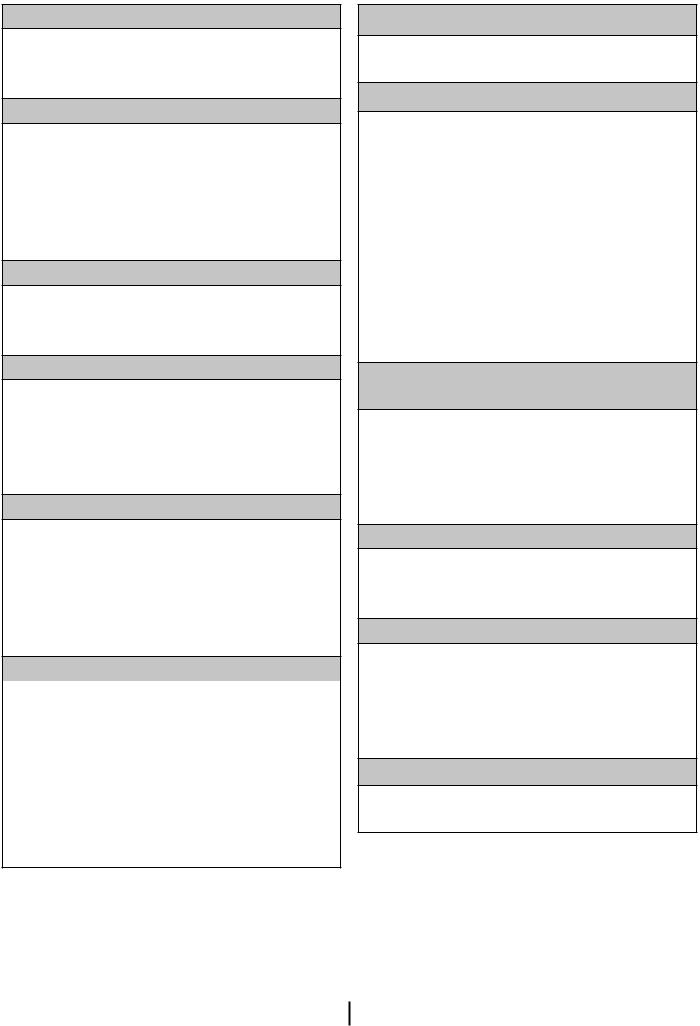
.ȠƾƁǍŽȚ ǍƸƱƫŮ ǀƷƸƃŵ ȔƾǤǞǤ ȞNjƇů
ȠƾƵƉƴŽ (ȠȶȚǍƵŽȚ)ȔȚǞƷŽȚ ȝƾƭƪƶž ȳNjƈƄƉůNjƯƁ ǽȶ ǠƯƸƃŶ Țnjƀȶ.ȲƾƯź ǚƳƪŮ NjƁǍƃƄŽƾŮ ǀűǾƅƴŽ
.ȹƾƃƸŸǙŽȣ
.ǀűǾƅƴŽ ǀƸƴųȚNjŽȚ ǓǣȚǞƇŽȚ Ǡź ǗŰƾƳů
.ǗŰƾƳƄŽȚȶ ǃƸƴƅƄŽȚ ǜž ƿŶǍŽȚȶ ȤƾƇŽȚ ǏƲƭŽȚ NjƁǎƁ
.ȹƾƃƸŸ ǙŽȣ NjƯƁ ǽȶ ǠƯƸƃŶ Țnjƀȶ
.ƾȹžƾƵů ǀƲƴưž țȚǞŮLjȚ ȴȖ Njżƺů.ƾȹƸǣǎű ǀŲǞƄƱž țȚǞŮLjȚNjŻ ȶȖ ȚȹNjű ȜȤǍƳƄž ȜȤǞƫŮ ǀŲǞƄƱž țȚǞŮLjȚ ȴǞƳů NjŻțȚǞŮLjȚ ljƄźȚ.ǀƴƁǞŶ ȜǍƄƱŽ ǀŲǞƄƱž ǀżȶǍƄž ȴǞƳů
.ǚŻȖȤȚǍƳƄŮ
.țȚǞŮLjȚ ǜƸŮ ȶȖ ǀűǾƅƴŽ ǠűȤƾƈŽȚ ȤƾŶȁȚ Ǡź ǀŮǞŶǍŽȚ ȞNjƇů
Ǡź ȚȹNjű ǠƯƸƃŶ ȔǠŵ Țnjƀ.ƾȹƃŶȤ ǏƲƭŽȚ ȴǞƳƁ NjŻǠƱƄƈƁ ȑǚŻȖ ǀŮǞŶǍŽȚ ȴǞƳů ƾžNjƶŸȶ.ǀƃŶǍŽȚ ȔȚǞűLjȚ
.ǗƅƳƄŽȚ
.ǀűǾƅŽȚ ǚųȚȢ ǀƷƁǍż ǀƇǣȚȤ NjűǞů
ǚųȚȢ ǗƮſ .ǀűǾƅŽȚ ǜž ǠƴųȚNjŽȚ ȔǎƆŽȚ ǗƸƮƶů ƿƆƁ
.ǜŮǍƳž Ȕƾž ȶȖ ƽźȚȢ Ȕƾžȶ ǀƸƆƶƱŴȖ ǀƯƭƲŮ ǀűǾƅŽȚȵnjƀ Ǡź ǀƂƃƯƄŽȚ ȢȚǞž ȶȖ ǀƸŸȶLjȚ ǒƯŮ ƿƃƉƄů NjŻ
ǀƂƃƯů ȢȚǞž ȶȖ ǗƴƄƈž ȔƾŸȶ ȳNjƈƄŴȚ.ǀƇǣȚǍŽȚ
.ǀƱƴƄƈž
.ǘƴưƁ ǽ (țȚǞŮLjȚ) țƾƃŽȚ
ȝȚǞƃŸ ǕǤȶ ǍƸŹ .țƾƃŽȚ ȰǾŹȘ ǕƶƵů NjŻ ȳƾƯƭŽȚ ȝȚǞƃŸ
.țƾƃŽȚǘƸƯůǠƄŽȚȳƾƯƭŽȚǎƄƷů NjŻȶ ȩȤLjȚ ǟƴŸ ƾȹžƾƵů ƾȹƁȢǞƵŸ ǁƉƸŽ ǀűǾƅŽȚ
.ȬƾƱůȤǽȚǍƸžƾƉžǓƃǤȚȹǾƸƴŻƾƷƳƁǍƇůNjƶŸȩȤLjȚ ȴȖ ǜž Njżƺů .ǀƁǞŻ ȶȖ ǀƁǞƄƉž ǁƉƸŽ ȩȤLjȚ
.ǀűǾƅŽȚǚƵƇƄůȶǀƁǞƄƉž
.ǀƲŽƾŸ ȟȚȤȢLjȚ |
|
ƿƸůǍů NjŸȖ .ȟȤNjŽȚ ǗƲƉŽ ƾ ȹƉžǾž ȳƾƯƭŽȚ ȴǞƳƁ NjŻ |
|
.ȟȤNjŽȚ Ǡź ȳƾƯƭŽȚ |
|
ƾȹƶųƾŴ ǃƄƶƵŽȚ ljƭŴ ȴƾż ȚȣȘ |
|
ϰ ϋϭ ˬϥϳΑΎΑ ϥϳΑ Γέ έΣ ΕΎΟέΩ ωΎϔΗέ υΣϼϳ Ωϗ |
|
ΞΗϧϣ ϝϳϐηΗ ˯ΎϧΛ Δϳϔ Χ Δϳ ϭη ϭ ΔϳΑϧΎΟ Ρ ϭ Ϸ |
|
˱έΫΣ ϥϛ ΔϧΎϳλ Ώ ρΗϳ Ύ˱Αϳϋ ϙ Ϋ Ωόϳ ϻϭ ϲόϳΑρ Ϋϫϭ |
|
ϥϛΎϣϷ ϩΫϫ αϣ Ωϧϋ |
|
.ǀűǾƅŽȚ ȰȶNjƶǧ ȟȚȤȢȖ Ǡź ȫǞƱƇƵŽȚ ȳƾƯƭŽȚ NjƵƆů
ǀűȤȢ ǓƃǤȚ .ȚȹNjű ȜȢȤƾŮ ǀűȤȢ ǟƴŸ ǀűǾƅŽȚ ǓƃǤ Ǜů
.ǀƸſƾŰ ǘƲƇů ǛŰ ǟƴŸȖ ǀűȤȢ ǟƴŸ ǀűǾƅŽȚ ȜȤȚǍŲ
.ȚȹNjű ǀƸŽƾŸ ȤǎƁǍƱŽȚ ȶȖ ǀűǾƅŽȚ ȜȤȚǍŲ ǀűȤȢ
ǍŰƻƁ .ȚȹNjű ǀƸŽƾŸ ȜȤȚǍŲ ǀűȤȢ ǟƴŸ ǀűǾƅŽȚ ǓƃǤ ǛůǀűȤȢ ǍƸŹ .ȤǎƁǍƱŽȚ ȜȤȚǍŲ ǀűȤȢ ǟƴŸ ǀűǾƅŽȚ ǓƃǤȷǞƄƉž ǟŽȘ ǚƫů ǟƄŲ ȤǎƁǍƱŽȚ ȶȖ ǀűǾƅŽȚ ȜȤȚǍŲ
.ƿŴƾƶž
.ƾȹžƾƵů țƾƃŽȚ ǘƴŹȖ.ƾȹƸǣǎű ȠǞƄƱž țƾƃŽȚ ȴǞƳƁ NjŻǛů ǜųƾƉŽȚ ȳƾƯƭŽȚ ǜž ȜǍƸƃż ȝƾƸƵż ȱƾƶƀ ȴǞƳů NjŻ
ǀűǾƅŽȚ ǚƫů ǟƄŲ ǍƮƄſȚ.ȚȹǍųƻž ǀűǾƅŽȚ Ǡź ƾƷƯǤȶ
.ǀŮǞƴƭƵŽȚ ȜȤȚǍƇŽȚ ǀűȤȢ ǟŽȘ ȤǎƁǍƱŽȚ ȶȖǀűǾƅŽȚ NjƁǍƃƄź .ȚǍųƻž ȔƾŮǍƷƳŽƾŮ ǀűǾƅŽȚ ǚƸǧǞů Ǜů
.ǛƆƇŽȚƿƃƉŮƾȹƄŻȶȰǍưƄƉƁƾȹžƾƵů
ȸnjŽȚ ǠſȚǞƅŽȚ ȝǞǧ ǀűǾƅŽȚ ǜŸ ǀƆůƾƶŽȚ ȔƾǤǞƬŽȚ ǝƃƪů
.ǀŸƾŴ ȵȤNjƫů
.ǀűǾƅƴŽ ǠƃŽǞƴŽȚ ȳƾƵǧ ǜž ȔƾǤǞƬŽȚ ȵnjƀ ȤNjƫůǍƃŸ ȤƾƉƵŽȚ NjƁǍƃů ȴƾƵǤ ȩǍưŮ ȳƾƵƫŽȚ Țnjƀ ǚƵƯƁ
ȜȤȚǍŲ ȝƾűȤȢ ǟƴŸ ǝƭƃǤ ǜƳƵƁ ȸnjŽȚȶ ȰȶNjƶƫŽȚ
.NjƁǍƃƄŽȚǗǣƾŷǞŮȳǞƲƁǝſȖƾƵżȆNjƸƵƆƄŽȚȶȖNjƁǍƃƄŽȚ
.ƾƃƸŸ ǏƸŽȶ ǠƯƸƃŶ ǍžȖ Țnjƀȶ
.ǀűǾƅŽȚ ǚƸưƪů NjƶŸ ǚƸưƪƄŽȚ ȔƾǤǞǤ ǕƱůǍů
ǀűȤȢ Ǡź ȝȚǍƸưƄƴŽ ƾƯƃů ǀűǾƅŽȚ ȔȚȢȖ ȝƾƵŴ ǍƸưƄů NjŻǙŽȣ NjƯƁ ǽȶ ǠƯƸƃŶ Țnjƀȶ.ǀűǾƅŽƾŮ ǀƭƸƇƵŽȚ ȜȤȚǍƇŽȚ
.ȹƾƃƸŸ
.ȔƾǤǞǤ ȶȖ ȝȚȥȚǎƄƀȚ
ǀűǾƅŽȚ ǎƄƷů .ǀƃƴǧ ǁƉƸŽ ȶȖ ǀƁǞƄƉž ǁƉƸŽ ȩȤLjȚǀƁǞƄƉž ȩȤLjȚ ȴȖ ǜž Njżƺů.ȔǓƃŮ ƾƷƳƁǍƇů NjƶŸ
.ǀűǾƅŽȚǚƵƇƄůȶǀƁǞŻȶǀűǾƅŽȚ ǟƴŸ ǀŸǞǤǞƵŽȚ ȔƾƸŵLjȚ ǜž ȝǞǧ ȤNjƫƁ NjŻ
.ǀűǾƅŽȚ ljƭŴ ǟƴŸ ǜž ȔƾƸŵLjȚ ȵnjƀ ǀŽȚȥȘ ƿƆƁ
.ǝŵȤ ȶȖ ǚǣƾŴ țƾƳƉſȚ ȝǞǧ ǚƅž ȔƾǤǞǤ ȤNjƫů
ǚƸưƪů NjŸȚǞƲŽ ƾƲźȶ ȝȚȥƾưŽȚȶ ǚǣȚǞƉŽȚ țƾƉƶů
.ȹƾƃƸŸ ǙŽȣ NjƯƁ ǽȶ ǠƯƸƃŶ Țnjƀȶ.ǀűǾƅŽȚ
18 AR

ΕϼϛηϣϠϟ ΔΣέ Ϙϣ ϝϭϠΣ7 |
|
|
|
ǎżǍƵŮ ȲƾƫůǽȚ ǚƃŻ ǀƵǣƾƲŽȚ ȵnjƀ ǀƯűȚǍž ǟűǍƁ |
|
.ǚƁǞŶ ǁŻǞŽ ȶȖ ȜȤǍƳƄž ȜȤǞƫŮ ǀűǾƅŽȚ ǚƵƯů |
|
|||
|
ȵnjƀ ǚƵƪů .ȹǽƾžȶ ƾȹƄŻȶ ǙƸƴŸ ǍźǞƁ NjƲź.ǀžNjƈŽȚ |
|||
Țnjƀ .ǀƵƁNjƲŽȚ ǜž ǍƃżȖ ȜNjƁNjƆŽȚ ǀűǾƅŽȚ ȴǞƳů NjŻ |
|
|
||
|
ȶȖ ǀŸƾƶǧ țǞƸŸ ǜŸ ǃƄƶů ǛŽ ǠƄŽȚ ȷȶƾƳƪŽȚ ǀƵǣƾƲŽȚ |
|||
ȝȚǍƄƱŽǚƵƯůȜǍƸƃƳŽȚȝƾűǾƅŽȚ.ƾȹžƾƵůǠƯƸƃŶȔǠŵ |
|
|
||
|
|
ȜȢȚȤǞŽȚ ȝȚǎƸƵŽȚ ǒƯŮ ǍźȚǞƄů ǽ NjŻ .ǀžNjƈƄƉƵŽȚ ȢȚǞƵŽȚ |
||
.ȲǞŶȖ |
|
|
||
|
|
.ǙŮ ȨƾƈŽȚ ǃƄƶƵŽȚ Ǡź ǚƸŽNjŽȚ Țnjƀ Ǡź |
||
ǍžȖ Țnjƀȶ .ǀƸŽƾŸ ǀƭƸƇƵŽȚ ȜȤȚǍƇŽȚ ǀűȤȢ ȴǞƳů NjŻ |
|
|||
|
|
|
||
.ȚNjűǠƯƸƃŶ |
|
|
|
|
|
|
ϝϣό ϻ ΔΟϼ ϟ |
||
ǀƂƸƴž ȶȖ ǚƸƴŻ njƶž ȔƾŮǍƷƳŽƾŮ ǀƴƫƄž ǀűǾƅŽȚ |
|
|||
ȝƾŸƾƉŽ ȹǀƸƴżǀűǾƅŽȚNjƁǍƃůǍƵƄƉƁNjŻ.ȳƾƯƭŽƾŮ |
|
|
ǏŮƾƲŽȚ ǚƸǧǞů ȒǠŮǍƷƳŽȚ ȤƾƸƄŽƾŮ ǀƴƫƄž ǀűǾƅŽȚ ǚƀ |
|
.ȲǞŶȖ |
|
|
. |
|
Ǜů ǜųƾƉŽȚ ȳƾƯƭŽȚ ǜž ȜǍƸƃż ȝƾƸƵż ȱƾƶƀ ȴǞƳů NjŻ |
|
|
ǓǣƾƇŽƾŮȔƾŮǍƷƳŽȚnjƱƶƵŮ |
|
|
ȶȖ ǀűǾƅŽȚ ǝŮ ǀƴƫƄƵŽȚ ǏŮƾƲŽȚ ǍƷƫƶž ȰǍƄŲȚ ǚƀ |
|||
ǜųƾƉŽȚȳƾƯƭŽȚƿƃƉƄƁ.ȚȹǍųƻžǀűǾƅŽȚǠźƾƷƯǤȶ |
|
|
. |
|
ȜȤȚǍŲ ǀűȤȢ ǟŽȘ ǚƫƁ ǟƄŲ ǀűǾƅŽȚ ǚƸưƪů Ǡź |
|
|
ǍƷƫƶƵŽȚǑƇźȚȒǠƉƸǣǍŽȚǍƷƫƶƵŽȚ |
|
|
|
ȆȜȢNjƯƄƵŽȚ ǀƲƭƶƵŽȚ) .ǀűǾƅŽȚ ȰȶNjƶǧ ƿſƾű Ǡź ǗƅƳů |
||
.ǀƶžȃȚǜƁǎƈƄŽȚ |
|
|
(ǀſǍƵŽȚ ǀƲƭƶƵŽȚȶ ȆNjƁǍƃƄŽȚ Ǡź ǛƳƇƄŽȚ |
|
ǀŲǞƄƱž ȶȖ ȜȤǍƳƄž ȜȤǞƫŮ ǀŲǞƄƱž țȚǞŮLjȚ ȴǞƳů NjŻ |
|
ƾƷƲƴŹȶ țȚǞŮLjȚ ljƄź .ȚȹNjű ȜȢȤƾŮ ǀƭƸƇƵŽȚ ȯȶǍƮŽȚ |
|
|
ǚųȢ ȸnjŽȚ ǜųƾƉŽȚ ȔȚǞƷŽȚ ƿƃƉƄƁ.ǀƴƁǞŶ ȜǍƄƱŽ ƾȹƸǣǎű |
|
|
||
|
|
.ǀŮǞŶǍŽȚǀƸŽƾŸǀƭƸƇƵŽȚȯȶǍƮŽȚ.ȤǍƳƄžǚƳƪŮ |
|
|
țȚǞŮLjȚ ljƄźȚ.ȲǞŶȖ ȜǍƄƱŽ ǀűǾƅŽȚ ǚƸưƪů Ǡź ǀűǾƅŽȚ |
|
|
|
|
|
|
.ǀŲǞƄƱž ǀƸŸȶȖ Ǡź ǚǣƾŴ ǟƴŸ ȸǞƄƇƁ ȳƾƯŶ ǜƁǎƈů |
|
|
.ȝȚǍƵŽȚ ǜž ǚŻȖ ȚȹȢNjŸ |
|
|
|
|
|
|
.ƾȹƸǣǎűȠǞƄƱžțƾƃŽȚȱǍů |
|
|
.ƾȹƸǣǎű ȠǞƄƱž ǀűǾƅŽȚ ȶȖ ȤǎƁǍƱŽȚ ȰȶNjƶǧ țƾŮ ȴǞƳƁ NjŻ |
|
|
||
|
.ȜȢȶǍŮ ǍƅżȖ ǀűȤNjŽȚ ǟŽȘ ȝƾƄŴǞžǍƄŽȚ ǕǤȶ ǍƸƸưů |
|||
.ƾȹžƾƵů ǀƲƴưž țȚǞŮLjȚ ȴȖ Njżƺů |
|
|
||
|
|
ȶȖ ƾ ȹŲǞƄƱž ǝƸź țƾƃŽȚ ȱǍů ȸnjŽȚ ǁŻǞŽȚ ǚƸƴƲů |
|
|
ǀűȤȢ ǓƃǤȚ .ȚȹNjű ȜȢȤƾŮ ǀűȤȢ ǟƴŸ ǀűǾƅŽȚ ǓƃǤ Ǜů |
|
.ǚŻȖȜȤǞƫŮǝžȚNjƈƄŴȚ |
|
|
ǟŽȘ ǚƫů ǟƄŲ ǍƮƄſȚȶ ǟƴŸȖ ǀűȤȢ ǟƴŸ ȤǎƁǍƱŽȚ ȜȤȚǍŲ |
|
|
|
|
|
|
ȜȢƾƵŮ ǀŲǞƄƱž ȝƾƁȶƾŲ Ǡź ȴǎƈƵŽȚ ȳƾƯƭŽȚ ǀƸƭưů |
||
.ǀŮǞƴƭƵŽȚȜȤȚǍƇŽȚǀűȤȢ |
|
|
.ǀƃŴƾƶž |
|
ȶȖ ƾȹƸŽƾŮ ȶȖ ƾ ȹƈƉƄž ȤǎƁǍƱŽȚ ȶȖ ǀűǾƅŽȚ țƾŮ ȲȥƾŸ ȴǞƳƁ NjŻ |
|
|
||
|
ǜž ǘƲƇƄŽȚȶ ǀźƾű ȧƾƵŻ ǀƯƭƲŮ ǗƅƳƄŽȚ ljƉž |
|||
ȲȥƾƯŽȚǗƮſ.ǀƇƸƇǧǍƸŹǀƲƁǍƭŮǁƃƅžȶȖƾ ȹƳƄƷƄž |
|
|
||
|
|
.ǝǣƾƲŮ |
|
|
ƿƃƉƄƁ ǙƄƷƄƵŽȚ ȶȖ ǗŽƾƄŽȚ ȲȥƾƯŽȚ ȴLj.ǝŽNjƃƄŴȚ ȶȖ |
|
|
|
|
|
|
ǚƵƯƁ ǽ ȔȚǞƷŽȚ ǓưǤ ȥƾƷű |
||
ǀűȤȢ ǟƴŸ ȫƾƱƇƴŽ ȲǞŶȖ ȝȚǍƄƱŽ ǀűǾƅŽȚ ǚƵƯů ȴȖ Ǡź |
|
|
||
. |
|
|
ȔƾƶŰȖ ȔȚǞƷŽȚ ǓưǤ ȥƾƷƆŽ ȸȤȚǍƇŽȚ ȲȥƾƯŽȚ ǍƷƫƶƸŴ |
|
ǀƸŽƾƇŽȚȜȤȚǍƇŽȚ |
|
|
ǏŮƾŻǚƸǧǞůȶȖǠŮǍƷƳŽȚȤƾƸƄƴŽƽűƾƱƵŽȚȬƾƭƲſǽȚ |
|
ȜȤȚǍŲ ǀűȤȢ ƾƵƶƸŮ ȚȹNjű ǀƬƱƈƶž ȤǎƁǍƱŽȚ ȜȤȚǍŲ ǀűȤȢ |
|
|
||
|
ǀűǾƅŽȚ ǓưǤ ȴLj Ȇǝƴƫź ȶȖ ǠŮǍƷƳŽȚ ȤƾƸƄŽƾŮ ǀűǾƅŽȚ |
|
||
.ǀƸźƾż ǍƸŹ ǀűǾƅŽȚ |
|
|
||
|
.NjƯŮ ȴȥȚǞƄƁ ǛŽ ǀűǾƅŽȚ NjƁǍƃů ȳƾƮſ Ǡź |
|
||
. |
|
|
ǟűǍƁ .ƾȹƃƁǍƲů ǘǣƾŻȢ6NjƯŮ ǚƵƯŽȚ Ǡź ǀűǾƅŽȚ ȖNjƃƄŴ |
|
ǀűȤȢ ǓƃǤȚ ȚȹNjű ȜȢȤƾŮ ǀűȤȢ ǟƴŸ ȤǎƁǍƱŽȚ ǓƃǤ Ǜů |
|
ǚƵƯŽȚ Ǡź ǀűǾƅŽȚ ȖNjƃů ǛŽ ȚȣȘ ǀſƾƸƫŽȚ ǎżǍƵŮ ȲƾƫůǽȚ |
|
|
. |
|
|
|
|
ǀƸſƾŰ Njżƺů ǛŰ ǟƴŸȖ ǀűȤȢ ǟƴŸ ȤǎƁǍƱŽȚ ȜȤȚǍŲ |
|
|
.ȜNjƵŽȚ ȵnjƀ ȔƾƷƄſȚ NjƯŮ |
|
ȜȤȚǍŲ ǀűȤȢ ƾƵƶƸŮ ȚȹNjű ǀƬƱƈƶž ǀűǾƅŽȚ ȜȤȚǍŲ ǀűȤȢ |
|
|
||
|
ǚƳŽ ȸȢƾŸ ǍžȖ Țnjƀ .ǃƴƅŽȚ ǀŽȚȥȘ ȜȤȶȢ Ǡź ǀűǾƅŽȚ |
|||
.ǀƸźƾż ǍƸŹ ȤǎƁǍƱŽȚ |
|
|||
|
ǀƸƴƵŸȞNjƇů.ǃƴƅŽȚǚƁǎůǠƄŽȚǀƸƳƸůƾžǞůȶLjȚȝƾűǾƅŽȚ |
|
||
ǀűȤȢ ǓƃǤȚ .ȚȹNjű ȜȢȤƾŮ ǀűȤȢ ǟƴŸ ǀűǾƅŽȚ ǓƃǤ Ǜů |
|
|
|
|
|
.ƾȹƁȤȶȢ ǃƴƅŽȚ ǀŽȚȥȘ |
|
||
.ǀƸſƾŰ ǘƲƇů ǛŰ ǟƴŸȖ ǀűȤȢ ǟƴŸ ǀűǾƅŽȚ ȜȤȚǍŲ |
|
|
|
|
|
|
ǏŮƾƲŽȚ ȴȖ Njżƺů .ǏŮƾƲŽƾŮ ǀƴƫƄž ǍƸŹ ǀűǾƅŽȚ |
||
|
|
|
||
|
|
|
.ǓǣƾƇŽȚǏƃƲžǠźȳƾƳŲƼŮȬǞǤǞž |
|
|
|
|
ȬƾƭƲſȚ ȒljƸƇǧ ǚƳƪŮ ȜȤȚǍƇŽȚ ǀűȤȢ ǓƃǤ Ǜů ǚƀ |
|
|
|
|
.ȔƾŮǍƷƳŽȚǀżǍƪŮǚƫůȚ.ǠŮǍƷƳŽȚȤƾƸƄŽȚ |
|
17 AR

ϑϳυ ϟ ϭ Δ Ύϳλϟ6
ϱϭΗΣΗ ϲΗ ϩΎϳϣ ϭ ϑϳυϧΗ Ω ϭϣ ˱ ΩΑ ϡΩΧΗγΗ |
|
ΔϬΑΎηϣ Ω ϭϣ ϱ ϭ ϥϳίϧΑ ϭ ϥϳ ϭίΎΟ ϡΩΧΗγΗ ϻ A |
|
C |
ϑϳυϧΗ ν έ Ϸ |
|
|
˯ ίΟϷ ϭ ΔϳΟέΎΧ ργϷ ϑϳυϧΗ ϥϳέϭ ϛ ϰ ϋ |
|
ϪϔϳυϧΗ ϝΑϗ ϲΑέϬϛ έΎϳΗ ϥϋ ίΎϬΟ ϝλϔΑ ϲλϭϧ A |
|
ϥϳέϭ ϛ Ύϓ ΞΗϧϣ ϥϣ ϡϭέϛ ΎΑ Δϳ ρϣ |
|
ϭ ϥϭΑΎλ ϭ ΔρηΎϛ Ω ϭϣ ϱ ˱ ΩΑ ϡΩΧΗγΗ ϻA |
|
ΔϳϧΩόϣ ργϷ ϩΫϫ ϝϛ Η ϲϓ ΏΑγΗϳ |
ϊϳϣ Η ϊϣη ϭ ϝϳγ ΕΎϔυϧϣ ϭ Δϳ ίϧϣ ΕΎϔυϧϣ |
|
|
ϭ ˬϥϭΑΎλ ϭ ΔρηΎϛ ϭ ΓΩΎΣ Ε ϭΩϷ ϡΩΧΗγΗ ϻ |
|
ϑϳυϧΗ Ωϧϋ |
|
C |
No Ξ Λ ϥϭϛΗ ϊϧϣΗ ϲΗ ΕΎΟΗϧϣ έϳ ϲϓ A |
||
ˬϊϣη ˬϥϳίϧΑ ˬΕΎϔυϧϣ ˬΔϳ ίϧϣ ϑϳυϧΗ Ω ϭϣ |
|
Ξ Λ ϡϛ έΗϳ ϥ ϥϛϣϳϭ ˯Ύϣ ρϗΎγΗϳ ˬ Frost |
|
ΔϳϛϳΗγϼΑ ˯ ίΟϷ ϰ ϋ ϡΎΗΧϷ ϝϭίΗγ ϻ ϭ ˬΦ |
|
ϲϔ Χ έ ΩΟ ϰ ϋ ϊΑλϹ νέϋ ϰ ϝλϳ έ ΩϘϣΑ |
|
ΔϣϋΎϧ ΔηΎϣϗϭ έΗΎϓ ˯Ύϣ ϡΩΧΗγ ϩϭηΗ ΙΩΣϳϭ |
|
ϝϣόΗγΗ ϻϭ ˬϪϔυϧΗ ϻ ΔΟϼΛ ϕϭΩϧλ ϲ Χ Ω |
|
ϑϳϔΟΗ ϭϑϳυϧΗ |
|
Ϫϳ ϋ ΛΎϣϣ ϝϣ ϭϋ ϭ ρϔϧ Ύ˱Ϙ ρϣ |
|
Δϳϛϳ γϼ ϟ ργϷ ΔϳΎϣΣ |
ΔΑρέ ΔϘϳϗΩ ΔΟγϧϷ ϥϣ εΎϣϗ Δόρϗ ρϘϓ ϡΩΧΗγ A |
||
εΩΧϳ Ωϗ ΞΗϧϣ ϲΟέΎΧ ργ ϑϳυϧΗ ˱ϼϳ ϗ |
|
||
ϲϓ Εϳί ΎΑ ΔΧϭΑρϣ ΕΎΑΟϭ ϭ Ύγ Ύ˱Ηϭϳί ϊοΗ ϻ C |
ργ ϑϳυϧΗ Δηϣϗ ϥϣ ϯέΧϷ ω ϭϧϷ ϭ ΞϧϔγϹ |
|
|
ΞΗϧϣ |
|
||
ϑ Η ϲϓ ΏΑγΗΗ Ωϗ Ϋ ˬΔ ϭίόϣ έϳ Ώ ϋ ϲϓ ΔΟϼΛ |
|
|
|
Εϳί ΏΎϛγϧ ΎΣ ϲϓ ΔΟϼΛ ΔϳϛϳΗγϼΑ ργϷ |
|
ϡΛ ΔΟϼΛ ϕϭΩϧλ ϑϳυϧΗ ΓέΗΎϔ ϩΎϳϣ ϡΩΧΗγ |
C |
˯ίΟ Ϋϫ ϑυϧ ˬΔϳϛΗγϼΑ ργϷ ϰ ϋ ϪΑέγΗ ϭ |
|
ϑΟϳ ϪΣγϣ |
|
Ίϓ Ω ˯ΎϣΑ ˱έϭϓ Ϫϔρη ϭ |
|
˯ϝϣ ϊϣ ΔΑρέ ϭ ΔϳϭΗ ϣ εΎϣϘ ϥϣ Δόρϗ ϡΩΧΗγ |
C |
|
|
||
|
|
ϥϭ ΎΟ ΔϓΎοϣ Ωϭλ ΕΎϧϭΑέϛϳΑ ϥϣ ϱΎη ΔϘό ϣ |
|
|
|
ϑϔΟϳ ϡΛ ϝΧ Ω ϑϳυϧΗ ˯Ύϣ ϥϣ |
|
|
|
ϩέϳ ϭ ΡΎΑλϣ ΕϳΑϣ ϰ ϩΎϳϣ ϝϭΧΩ ϡΩϋ ϥϣ Ωϛ΄ΗC |
|
|
|
Δϳ ΎΑέϬϛ έλΎϧό ϥϣ |
|
|
|
ˬΔ ϳϭρ Δϳϧϣί ΓέΗϔ ϝϣόΗγΗ ϥ ΔΟϼΛ ΕϧΎϛ Ϋ |
C |
|
|
ΔϣόρϷ ϊϳϣΟ ύέϓ ϡΛ ϲ ΎΑέϬϛ έΎϳΗ ϝΑΎϛ ϝλϓΎϓ |
|
|
|
˱Ύϳ ίΟ ΡϭΗϔϣ ΏΎΑ ϙέΗ ϭ ΎϬϔυϧ ϡΛ |
|
Ωϛ΄Η ϡΎυΗϧΎΑ ΏΎΑ ϲϓ ΏϳέγΗ ϝί ϭϋ ιΣϔΑ ϡϗ C
ϡΎόρ ΕΎ ϳίΟ ϥϣ Ύϫϭ Χϭ ΎϬΗϣϼγ ϥϣϊϓΩ ϡΛ ΕΎϳϭΗΣϣ ϊϳϣΟ ΝέΧ ˬΏΎΑ ϑϓέ ίϹ C
ΓΩϋΎϘ ϥϋ ˱ΩϳόΑ ϰ ϋϷ ΏΎΑ ϑέ
16 AR

ΓΩϣΟϣϟ ΔϣόρϷ ϰϠϋ ΔυϓΎΣϣϟ ΕΎϳλϭ
|
ΔϘΑγϣ ΔϳέΎΟΗ ΓΩϣΟϣ ΔϣόρϷ υϔΣ ΏΟϳ |
|
|||
|
ΔΑγϧ ΎΑ ΩϣΟϣ ϡΎόρ ϊϧλϣ Ε ΩΎηέϹ Ύ˱Ϙϓϭ ΑόΗ |
|
|||
|
ϡϭΟϧ 4 |
ΩϣΟϣ ϡΎόρ υϔΣ ϕϭΩϧλ |
|
||
ϊϳϧλΗ ΔϬΟ ϯΩ ΓΩϭΟ ϝοϓ ϰ ϋ ΔυϓΎΣϣ ϥΎϣο |
|
||||
|
ϲ ϳ Ύϣ έϛΫΗ ΏΟϳ ˭ϊ ΎΑ ϭ ΩϣΟϣ ϡΎόρ |
|
|||
|
ΩόΑ ϥϛϣϳ Ύϣ ωέγ΄Α έίϳέϔ ϲϓ Ε ϭΑό ϊοϭΗ |
1 |
|||
|
|
|
|
˯ έη |
|
|
ϥϭΩϣϭ ΓϭΑό ϰ ϋ ΔϘλ ϣ ΕΎϳϭΗΣϣ ϥ ϥϣ Ωϛ΄Η |
2 |
|||
|
|
|
|
ΦϳέΎΗ ΎϬϳ ϋ |
|
|
ϝοϔϳµ ϭ ¶ϰΗΣ ϡ ΩΧΗγ µ ΦϳέΎΗ ίϭΎΟΗ ϡΩϋ ΏΟϳ |
3 |
|||
|
|
|
|
ΓϭΑό ϰ ϋ ¶ϝΑϗ |
|
|
|
|
|
ΞϠ ϟ Δϟ ί· |
|
|
ϲ ΎϘ Η ϝϛηΑ Ξ Λ |
ίΈΑ έίϳέϔ ϑϳϭΟΗ ϡϭϘϳ |
|||
|
|
|
|
ϡΎόρϟ ϊοϭ |
|
|
|
|
|
ϝΛϣ ωϭϧΗϣ ΩϣΟϣ ϡΎόρ |
|
|
έίϳέϔ ϕϭΩϧλ ϑϓέ |
|
ϡϳέϛ αϳϵ ϭ ϙϣγ ϭ ϡΣ |
||
|
|
|
|
Φ Ε ϭέοΧ ϭ. |
|
|
|
νϳΑ ΝέΩ |
|
νϳΑ |
|
|
|
|
|
||
|
ΔΟϼΛ ϕϭΩϧλ ϑϓέ |
ΓΎρϐϣ ϕΎΑρ ϭ ΕΎΑ όϣ ϲϓ ϡΎόρ |
|||
|
|
ΔϘ ϐϣ Ώ ϋϭ. |
|||
|
|
|
|
||
|
ΔΟϼΛ ϕϭΩϧλ ΏΎΑ ϑϓέ |
ΕΎΑϭέηϣ ϭ ϑ ϐϣ ϭ ϝϳ ϗ ϡΎόρ |
|||
|
|
Ϫϛ ϭϔ έ Ύλϋϭ ϥΑ ϝΛϣ ) |
|||
|
|
|
|
||
|
|
ΝέΩ |
|
ΔϬϛΎϔ ϭ Ε ϭέοΧ |
|
|
ϡΎόρ ΔϘρϧϣ ϕϭΩϧλ |
|
ϥΑΟ ΔΑ όϣ ΔϣόρϷ ΕΎΟΗϧϣ |
||
|
|
ΝίΎρ |
|
Φ ϲϣϼγ ϭ ΩΑί ϭ.) |
|
ϕϳϣόϟ ΩϳϣΟ ϟ ΕΎϣϭϠόϣ
ϲϓ Ϫόοϭ Ωϧϋ ϥϛϣϳ Ύϣ ωέγ΄Α ϡΎόρ ΩϳϣΟΗ ΏΟϳϪΗΩϭΟ ϰ ϋ υΎϔΣ ΔΟϼΛ
Ωϧϋ ΓΩϳΩϋ έϭϬη ϡΎόρ ΔΟίΎρ ϰ ϋ υΎϔΣ ϥϛϣϳέίϳέϓ ΏϳΩ ϲϓ ϝϗ ϭ Γέ έΣ ΔΟέΩ
AέϳΫΣ
ϙϼϬΗγϼ ˱ΎϘΑρ ˯ ίΟ ϰ ΔϣόρϷ ϡϳγϘΗ ΏΟϳΔϳϣϭϳ ΔΑΟϭ ϭ Ύό ϲϣϭϳ
ϱ ϑΎϔΟ ϊϧϣ ΔϣϛΣϣ ΔϘϳέρΑ ΔϣόρϷ ϑϳ ϐΗ ΏΟϳέϳλϗ Εϗϭ υϔΣ˵Ηγ ΕϧΎϛ Ϋ ΎϬϧϣ
ΑόΗ Δϳέϭέο Ω ϭϣ
ΩέΑ ϡϭΎϘϣ ϕλϻ ρϳέη ϲΗ Ϋ ϕλϻ ρϳέη ΔϳρΎρϣ ΕΎϘ Σ ϡ ϗ
ϡΎόρ ΑόΗ ΎϬϣ ΩΧΗγ ϊϣίϣ Ω ϭϣ ϥϭϛΗ ϥ ΏΟϳνΎϣΣϷ ϭ Εϭϳί ϭ ΔΑϭρέ ϭ ΩέΑ ϭ ϊρϘ ΔϣϭΎϘϣ
Ω ϭϣ ΎϫΩϳϣΟΗ ϊϣίϣ ΔϣόρϷ Δγϣϼϣ ϡΩϋ ΏΟϳΔϳ ίΟ ΔΑ ΫϹ ϊϧϣ Ύ˱ϘΑΎγ ΔΑ Ϋϣ
Ύϣϛ ˬϪΗΑ Ϋ ΩόΑ ΓέηΎΑϣ ΩϣΟϣ ϡΎόρ ϡ ΩΧΗγ ΏΟϳΎ˱Ϙ ρϣ ϩΩϳϣΟΗ ΓΩΎϋ ϡΩϋ ΏΟϳ
15 AR

έϣΣϷ έη΅ϣϟ
˯ϲοϳ
ϰΗΣ ϝϣόϳ ϝυϳγ ˬϰ ϭϷ Γέϣ ίΎϬΟ ϝϳϐηΗ ΩϧϋϝϳϐηΗ ϝΑϗ Ύϣ Γέ έΣ ΔΟέΩ ϰ ϋ ϝϭλΣ ϡΗϳ
ΔΟίΎρ Δϣόρ΄Α ίΎϬΟ Ω ί ϝϳϣΣΗ ϡΗ Ϋ ΏΩλϗ ϥϭΩΑ ˱ΎΣϭΗϔϣ ίΎϬΟ ΏΎΑ ϙέΗ Ϋ ˰Ο
ΕΎ γϭϣέ ϟ ν Ϙϣ
έη΅ϣ ΡΎΑλϣ ϝϛϳϫ ϰ ϋ ΕΎΗγϭϣέΛ νΑϘϣ ΕΑΛϳ
ϡΎϫ
ϝϳΩόΗ ϭ ϊϳέγ ΩϳϣΟΗ ΡΎΗϔϣ ϰ ϋ ρϐο ΩϧϋϝΑϗ έϳλϗ έϳΧ΄Η ΙΩΣϳ Ωϗ ˬΔρϭΑοϣ Γέ έΣ ΔΟέΩϙ Ϋ Ωόϳ ϻϭ ϲόϳΑρ Ϋϫϭ ˯ ϭϬ ρ Ύο ϝϣϋ ˯ΩΑ
ρ Ύο ϲϓ ˱ΎΑϳϋ
ΩϳϣΟ ϟ
ϡΎόρϟ ΩϳϣΟ
ΏΎΑ ϰ ϋ ίϣέ ΫϬΑ ΩϳϣΟΗ ΔϘρϧϣ ΩϳΩΣΗ ϡΗ
ΝίΎρ ϡΎόρ ΩϳϣΟΗ ίΎϬΟ ϡ ΩΧΗγ ϙϧϛϣϳϩΩϳϣΟΗ ϕΑγ ϱΫ ϡΎόρ ϥϳίΧΗ ϰ ΔϓΎοϹΎΑ
Ε ϭΑϋ ϰ ϋ ΓΎρόϣ ΕΎϳλϭΗ ϰ ωϭΟέ ϰΟέϳ
ϙΑ ΔλΎΧ ΔϣόρϷ
Ϫϳ
ϥ ϥϛϣϳ ΙϳΣ ˬΔϳίΎϐ ΕΎΑϭέηϣ ΩϳϣΟΗΑ ϡϘΗ ϻΎϬ Χ ΩΑ ΩϭΟϭϣ ϝ Ύγ ΩϣΟΗ Ωϧϋ ΔΟΎΟί έΟϔϧΗ
Ξ Λ ΕΎΑόϛϣ ϝΛϣ ΕΎΟΗϧϣ ΩϳϣΟΗ Ωϧϋ ˱έΫΣ ϥϛΔϧϭ ϣ
ϡϭϳ ϲϓ ϙίΎϬΟΑ ΔλΎΧ ΩϳϣΟΗ Δόγ ίϭΎΟΗΗ ϻϑϳϧλΗ ϕλ ϣ έυϧ
Δϳ ϣϋ ϝϣΗϛΗ ϥ ΏΟϳ ˬϡΎόρ ΓΩϭΟ ϰ ϋ υΎϔΣΔϋέγ ϥϣ ϥϛϣϣ έΩϗ έΑϛ΄Α ΩϣΟΗ
ΔΟέΩ ϊϔΗέΗ ϥ ϭ ΩϳϣΟΗ Δόγ ίϭΎΟΗ ϡΗϳ ϥ ˬϡΛ ϥϣϭέίϳέϔ ϝΧ Ω Γέ έΣ
Ϫϳ
ϥϋ ˱ϼλϔϧϣ ϝόϔ ΎΑ ΩϣΟϣ ϡΎόρ υϔΣΑ ˱Ύϣ Ω ϡϗ˱ΎΟίΎρ ωϭοϭϣ ϡΎόρ
ΩϳέΑΗ ρ Ύο ϝϣόϳ ϑϭγ ˬΔϧΧΎγ Δϣόρ ΩϳϣΟΗ Ωϧϋϙ Ϋ ΏΑγϳ ϥ ϥϛϣϳ ϝϣΎϛ ΎΑ ϡΎόρ ΩϳϣΟΗ ϡΗϳ ϰΗΣΔΟϼΛ ϑϳϭΟΗ Ω ί ΩϳέΑΗ ϲϓ ˱ΎΗϗ΅ϣ
Ϫϗϼ ΩόΑ έίϳέϔ ΏΎΑ Ηϓ ϲϓ ΔΑϭόλ ΕΩΟϭ Ϋρϐο ϑϼΗΧ ϰ ϊΟέϳ ϙ Ϋϓ ϕ ϘΗ ϼϓ ˬΓέηΎΑϣΔϘϳέρΑ Ηϔ ΎΑ ΏΎΑ ϣγϳ ϪΗ ΩΎόϣ ϡΗϳ ϑϭγ ϱΫ ϭϳ ϗ ϕ ΎϗΩ ΩόΑ ΔϳόϳΑρ
ΓέηΎΑϣ ΏΎΑ ϕϼ ΩόΑ ώϳέϔΗ Εϭλ ωΎϣγ ϡΗϳγΎ ˱ϣΎϣΗ ϲόϳΑρ ˯ϲη Ϋϫ
ΞϠ ϟ ΕΎ όϛϣ ϝϣϋ
ϲϓ Ϫόοϭ ˯Ύϣ ΎΑ Ξ Λ ΕΎΑόϛϣ ΝέΩ ϸϣέίϳέϔ
Ν έΧ ϙϧϛϣϳ ˬΞ Λ ϰ ˯Ύϣ ϝϭΣΗϳ ϥ ΩέΟϣΑΞ Λ ΕΎΑόϛϣ
ϙϭη ϭ ϥϳϛΎϛγ ϝΛϣ ΓΩΎΣ Ε ϭΩ ˱ΩΑ ϡΩΧΗγΗ ϻΡέΟΗ ϥ ϥϣ έρΧ ϙΎϧϬϓ Ξ Λ ΕΎΑόϛϣ Ν έΧϹϙγϔϧ
ωΎϗ ϊο ϭ ˬϝϳγΗ Ξ Λ ΕΎΑόϛϣ ϙέΗ ˬϙ Ϋ ϥϣ ˱ϻΩΑΓέϳλϗ ΓέΗϔ ϥΧΎγ ˯Ύϣ ϲϓ ΝέΩ
ϊϳέγϟ ΩϳϣΟ ϟ
ˬΔΟίΎρ ΔϣόρϷ ϥϣ ΓέϳΑϛ ΕΎϳϣϛ ΩϳϣΟΗ ΎΣ ϲϓϝΑϗ ΔϋΎγ 24 ϊϳέγ ΩϳϣΟΗ ΡΎΗϔϣ ϰ ϋ ρϐο
ϊϳέγ ΩϳϣΟΗ ϑϳϭΟΗ ϲϓ ΔΟίΎρ ΔϣόρϷ ϊοϭ
24 ΓΩϣ ϊϳέγ ΩϳϣΟΗ ΡΎΗϔϣ ϝϳϐηΗ ΓΩηΑ ϰλϭϳ
ΓΩϣΟϣ ΔϣόρϷ ϥϣ ϯϭλϗ Δϳϣϛ ΩϳϣΟΗ ΔϋΎγ˱ ΩϳΟ έΫΣ ΥϭΗ ΩϳϣΟΗ Δόγ ΏγΣ ΎϬΑ ΡϭϣγϣΔΟίΎρ ΔϣόρϷΎΑ ΓΩϣΟϣ ΔϣόρϷ ρ Χ ϡΩό
14 AR

ίΎϬΟϟ ϥϋ ΞϠ ϟ Δϟ ί·
ίΎϬΟ ΩϳέΑΗ ˯ Ω ϰ ϋ Ω ί Ξ Λ ϥϭϛΗ έΛ΅ϳ ϑϭγϙΑ ιΎΧ
Δϧγ ϲϓ ϥϳΗέϣ ίΎϬΟ ϥϣ Ξ Λ ίΈΑ λϧϧ ϙ Ϋ ϭϡϣ 7 Ξ Λ ϥϭϛΗ ϯΩόΗϳ ΎϣΩϧϋ ϭ ˬϝϗϷ ϰ ϋ
ϙΎϧϫ ϥϭϛϳ ΎϣΩϧϋ ρϘϓ ίΎϬΟ ϥϣ Ξ Λ ίΈΑ ϡϗϡΎόρ ΩΟϭϳ ϻ ϭ ϪΑ ϝϳ ϗ ϡΎόρ
ϑϳ ϐΗΑ ϡϗ Ν έΩϷ ϥϣ ΓΩϣΟϣ ΔϣόρϷ ΝέΧΔϳϧΎρΑ ϭ ϕέϭ ϥϣ ΕΎϘΑρ ΓΩϋ ϲϓ ΩϣΟϣ ϡΎόρ
ΩέΎΑ ϥΎϛϣ ϲϓ Ϫόοϭ
ϑΎϘϳΈΑ ϡϗ ϭ ϲΑέϬϛ έΎϳΗ ϥϋ ίΎϬΟ ϝλϔΑ ϡϗΞ Λ ί Δϳ ϣϋ ˯ΩΑ Ϫ ϳϐηΗ
ϥϣ Φ Ν έΩϷ ϭ ϑϓέϷ ϝΛϣ ΕΎϘΣ ϣ ΝέΧϝΎγϣ ˯Ύϣ ϊϣΟ ΏγΎϧϣ ˯Ύϧ ϡΩΧΗγ ϭ ίΎϬΟ
ϑϳϔΟΗ ϡϋΎϧ εΎϣϘ ϭ ΞϧϔγϷ ϥϣ Δόρϗ ϡΩΧΗγ Γέϭέο Ωϧϋ ϝΎγϣ ˯Ύϣ
Ξ Λ ί ˯ΎϧΛ Ύ ˱ΣϭΗϔϣ ΏΎΑ ϙέΗ
ϲϓ Ίϓ Ω ˯Ύϣ ϪΑ ˱˯Ύϧ ϊο ˬΔϋέγΑ Ξ Λ ίϹίΎϬΟ
Ξ Λ ί ί ίέ ϭ Δϳ ΎΑέϬϛ ΓίϬΟ ˱ΩΑ ϡΩΧΗγΗ ϻϭ ϥϳϛΎϛγ ϝΛϣ ΓΩΎΣ ΔϓΎΣ ϭ Γέϔη Ε Ϋ Ε ϭΩ ϭ
Ξ Λ ίϹ ϙ ϭηϷ
ϥϣ ίΎϬΟ ϑυϧ ˬΞ Λ ί Δϳ ϣϋ ϥϣ ˯ΎϬΗϧϻ ΩόΑΔϳΎϧό ϭ ϑϳυϧΗ ϡγϗ έυϧ ϝΧ Ω
ϡΎόρ ϊο Δϳγϳ έ ˯ ίΟϷΎΑ ίΎϬΟ ϝϳλϭΗ Ωϋέίϳέϔ ϲϓ Ν έΩϷ ϝΧΩ ϡΛ Ν έΩϷ ϲϓ ΩϣΟϣ
ΝϭΩίϣϟ Ωϳέ ϟ ϡΎυ
ϕϭΩϧλ ΩϳέΑΗ ϥϳ λϔϧϣ ΩϳέΑΗ ϲϣΎυϧΑ ΓΩϭίϣ ΔΟϼΛ˯ ϭϬ ϥΈϓ ϲ ΎΗ ΎΑϭ έίϳέϔ ϕϭΩϧλϭ ΝίΎρ ϡΎόρ
ϻ έίϳέϔ ϕϭΩϧλϭ ΝίΎρ ϡΎόρ ϕϭΩϧλ ϲϓϝοϓ ϥϳ λϔϧϣ ΩϳέΑΗ ϲϣΎυϧ ϥϷ ϙ Ϋϭ ϥΎρ ΗΧϳϝΧ Ω ΔΣ έ ϥ Ύϣϛ ϯέΧϷ ΕΎΟϼΛ ϥϣ έϳΛϛΑ
Γίϳϣ Ύοϳ ϙΎϧϫ ϥ Ύϣϛ Ύοϳ ρ ΗΧΗ ϻ ϥϳϗϭΩϧλί ΕΎϳ ϣϋ ϥϷ έυϧ ˬΔϳϓΎοϹ ΔϗΎρ έϳϓϭΗ
ϘΗγϣ Δϳ ΎϘ Η ΩϳϣΟΗ
ΔΟίΎρϟ ΔϣόρϷ ΩϳϣΟ
ΔΟϼΛ ϲϓ Ϫόοϭ ϝΑϗ ϡΎόρ ΔϳρϐΗ ϭ ϑϳ ϐΗΑ ϡϗ |
|
Δϓέϐ Γέ έΣ ΔΟέΩ ϰ ϥΧΎγ ϡΎόρ ΩϳέΑΗ ΏΟϳ |
|
ΔΟϼΛ ϲϓ Ϫόοϭ ϝΑϗ |
|
Ύ ˱ΟίΎρϭ ˱ΩϳΟ ϩΩϳϣΟΗ Ω έϣ ϡΎόρ ϥϭϛϳ ϥ ΏΟϳ |
|
ϙϼϬΗγϼ ˱ΎϘΑρ ˯ ίΟ ϰ ΔϣόρϷ ϡϳγϘΗ ΏΟϳ |
|
Δϳϣϭϳ ΔΑΟϭ ϭ Ύό ϲϣϭϳ |
|
ϱ ϑΎϔΟ ϊϧϣ ΔϣϛΣϣ ΔϘϳέρΑ ΔϣόρϷ ΑόΗ ΏΟϳ |
|
έϳλϗ Εϗϭ υϔΣ˵Ηγ ΕϧΎϛ Ϋ ΎϬϧϣ |
|
Ωο ΑόΗ ϲϓ ΔϣΩΧΗγϣ Ω ϭϣ ϥϭϛΗ ϥ ΏΟϳ |
|
Εϭϳί ϭ ΔΣ έ ϭ ΔΑϭρέ ϭ ΩέΑ ΔϣϭΎϘϣϭ ϊρϘ |
|
˯ ϭϬ ΔϣϛΣϣ ϥϭϛΗ ϥ ΏΟϳ Ύϣϛ νΎϣΣϷ ϭ |
|
Ω ϭϣ ϩΫϫ ϥϭϛΗ ϥ ΏΟϳ ˬϙ Ϋ ϰ ΔϓΎοϹΎΑϭ |
|
ΔΑγΎϧϣϭ ϡ ΩΧΗγϻ Ϭγ Ω ϭϣ ϥϣ Δϋϭϧλϣϭ ΔϘ ϐϣ |
|
έίϳέϓ ΏϳΩ ϲϓ ϡ ΩΧΗγϼ |
|
Ύϣϛ ˬϪΗΑ Ϋ ΩόΑ ΓέηΎΑϣ ΩϣΟϣ ϡΎόρ ϡ ΩΧΗγ ΏΟϳ |
|
Ύ˱Ϙ ρϣ ϩΩϳϣΟΗ ΓΩΎϋ ϡΩϋ ΏΟϳ |
|
ϝοϓ ϰ ϋ ϝϭλΣ ΔϳΗϵ ΕΎϣϳ όΗ ωΎΑΗ ϰΟέϳ |
|
Ξ ΎΗϧ |
|
ϲϓ ΓΩΣ ϭ Γέϣ ϡΎόρ ϥϣ ΓέϳΑϛ ΕΎϳϣϛ ΩϳϣΟΗΑ ϡϘΗ ϻ |
1 |
ϝοϓ ϝϛηΑ ϡΎόρ ΓΩϭΟΑ υΎϔΗΣϻ ϡΗϳ Εϗϭ αϔϧ |
|
Εϗϭ ωέγ ϲϓ ϝϣΎϛ ΎΑ ΔΣϳΣλ ΔϘϳέρΑ ϩΩϳϣΟΗ Ωϧϋ |
|
ϥϛϣϣ |
|
ϰ έίϳέϔ ϑϳϭΟΗ ϲϓ Ίϓ Ω ϡΎόρ ϊοϭ ΏΑγΗϳ |
2 |
ϡΎόρ ΩϳϣΟΗ ϡΗϳ ϰΗΣ έ έϣΗγΎΑ ΩϳέΑΗ ϡΎυϧ ϝϣϋ˱ΎΑ λ Ϫ όΟϭ
˱Ύϳ όϓ ΓΩϣΟϣ ΔϣόρϷ ρ Χ ϡΩό ˱ ΩϳΟ έΫΣ ΥϭΗ 3
ΔΟίΎρ ΔϣόρϷΎΑ
13 AR
